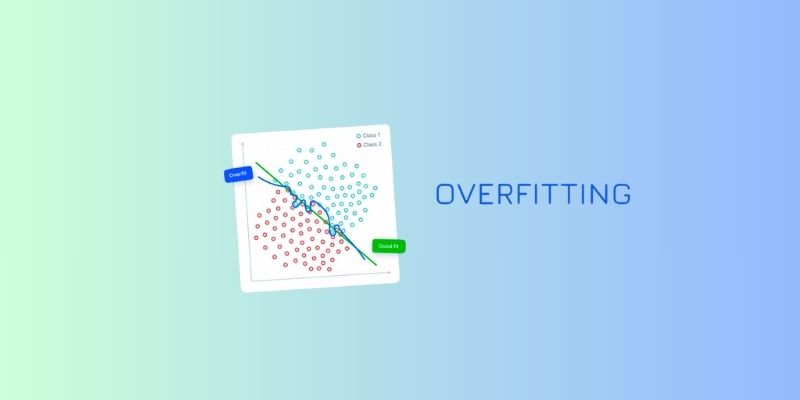Advertisement
In machine learning, overfitting is a prevalent problem, particularly for novices. After training a model, it performs remarkably on your data. When tested on fresh data, the outcomes may remain unsatisfactory. Why may this occur? The model has learned noise rather than the actual patterns. That renders it less helpful for practical tasks. You want to avoid overfitting whether your models are for analysis or prediction.
You can correct it with basic effort. You don't want complicated answers. Your model can improve significantly with the correct actions. This article will teach you simple, quick methods to prevent overfitting. These techniques apply to anyone regardless of skill level. Let's look at how to create dependable, intelligent machine-learning models.

Overfitting happens when a machine learning algorithm learns the training data too well, including its noise and minor details, instead of focusing only on the key patterns. As a result, the model performs brilliantly on the training data but poorly on new, unseen data. It's like a student memorizing practice questions but can't answer varied ones on the test.
Usually, overfitting results from either too small training data or overly sophisticated models. The model diminishes its generalizing capacity by trying to fit every point precisely, including the outliers. While practicing, you could find great accuracy, but you may find poor accuracy during testing. It is quite obviously overfitting. Any model can have it, from deep learning networks to decision trees. Machine learning aims to make predictions that apply to real-world data rather than only to training samples.

Here are some simple and effective ways to avoid overfitting in machine learning models and improve generalization:
Reducing overfit is mostly dependent on using more training data. According to the model, one learns better patterns and finds more examples. More data clarifies what noise is and what counts. It is more likely to generalize than commit the facts to memory. Data augmentation will help you if gathering fresh data is difficult. Modifying the current data is required to generate fresh samples. For instance, you might flip, trim, or rotate photos. These few adjustments bring helpful variation. Giving your model more to learn from increases performance, whether using real or augmented data.
Less likely to overfit is a basic model. Layers and too many parameters abound in complex models. They acquire not only the patterns but also the noise. They so perform badly on unseen data. Start with a basic and modest model. Use more complicated ones just when necessary. For minor tasks, use simpler methods, including linear regression or decision trees. If your dataset is tiny or lacks variation, steer clear of deep learning. Maintaining a modest model size speeds up training and helps model management.
One dependable method to evaluate the performance of your model is Cross-validation. It looks at the model's performance on several data points. K-fold Cross-validation is the most often applied technique. It divides your data into k sections, trains on k-1 sections, and tests the rest. It runs k times; each component is a test set once. The averaged results follow from this. This approach finds early overfitting. It also guides the selection of hyperparameters and ideal models. One of the key tools to ensure your model's performance on fresh and untested data is Cross-validation.
One effective weapon for managing overfitting is regularizing. It proceeds by penalizing the loss function of the model. This penalty helps the model not to grow overly complicated. L1 (Lasso) and L2 (Ridge) regularization are the most common forms. L1 eliminates superfluous features, therefore simplifying the model. L2 helps less valuable features weigh less. Both techniques compel the model to pay close attention to what counts. Regularizing is quite useful when you have several input features. It maintains a more general, simple, stable model.
Decision trees are easy to overfit. They develop extensively and pick every aspect from the training set. They thus perform badly on fresh data. Pruning removes small value-adding branches, therefore addressing this issue. Limit depth, lower the number of leaves, or specify a minimum sample size for each split to regulate tree size. These adaptations enable the tree to remain concentrated on the most critical splits. You can obtain the optimal pruning values through a grid search. A pruned tree performs better on fresh data, is simpler to understand, and speeds through training.
One basic approach to lower overfitting in deep learning models is dropout. It operates by randomly off-targeting some neurons in training. It keeps the network from leaning overly on any one neuron or route. Every training session employs a somewhat different model. It drives the network to acquire more strong, broad properties. Dropout advances model stability and test performance. Frameworks like TensorFlow or PyTorch let you quickly build dropout layers. Common dropout rates run from 0.2 to 0.5. It's useful for lowering overfitting in big neural networks, including several hidden layers.
One approach to halting training when the model begins to overfit is early stopping. You follow the performance on a validation set throughout training. Training ends if the validation loss stops improving for numerous rounds. It stops the model from learning noise. It preserves resources and time and aids in maintaining the general integrity of the model. Deep learning models require several epochs to train to find great benefits from early stopping. For best results, combine early stopping with dropout and regularization. It's simple to apply and significantly improves the actual performance of your model.
Machine learning models often face overfitting, but you can control it with the right techniques. Your model's generalization capacity will increase by using more data, streamlining models, and applying Cross-validation, regularizing, dropout, and early stopping strategies. Reducing overfitting also comes from cutting decision trees and avoiding too complicated models. These techniques guarantee that your model excels on real-world tasks and training data. Applying these ideas will help you produce better and more consistent machine learning outcomes regardless of expertise. Start small, test constantly, and give general performance top priority.
Advertisement

Explore how generative AI transforms knowledge management with smarter search, automation, and personalised insights

What if your AI coding partner actually understood your project? See how Meta’s Code Llama 70B helps developers write smarter, cleaner, and more reliable code

Trying to choose between ChatGPT and Google Bard? See how they compare for writing, research, real-time updates, and daily tasks—with clear pros and cons

Want to launch surveys quickly? Learn how Survicate lets you create and customize surveys with ease, collecting valuable customer feedback without hassle

Discover how a steel producer uses AI to cut costs, improve quality, boost efficiency, and reduce downtime in manufacturing

Explore the features, key benefits, and real-world use cases of ERP AI chatbots transforming modern enterprise workflows.

Discover key differences: supervised vs. unsupervised learning, when to use one or the other, and much more.

Explore real vs. perceived risks of AI beyond fear-mongering and media hype in this balanced, insightful analysis.

Discover simple ways to avoid overfitting in machine learning and build models that perform well on real, unseen data every time

Learn how to build a machine learning model in 7 easy steps, from defining the problem to deploying the model.

Explore the modern AI evolution timeline and decade of AI technology progress, highlighting rapid AI development milestones

Boost your productivity with these top 10 ChatGPT plugins in 2025. From task management to quick research, discover plugins that save time and streamline your work